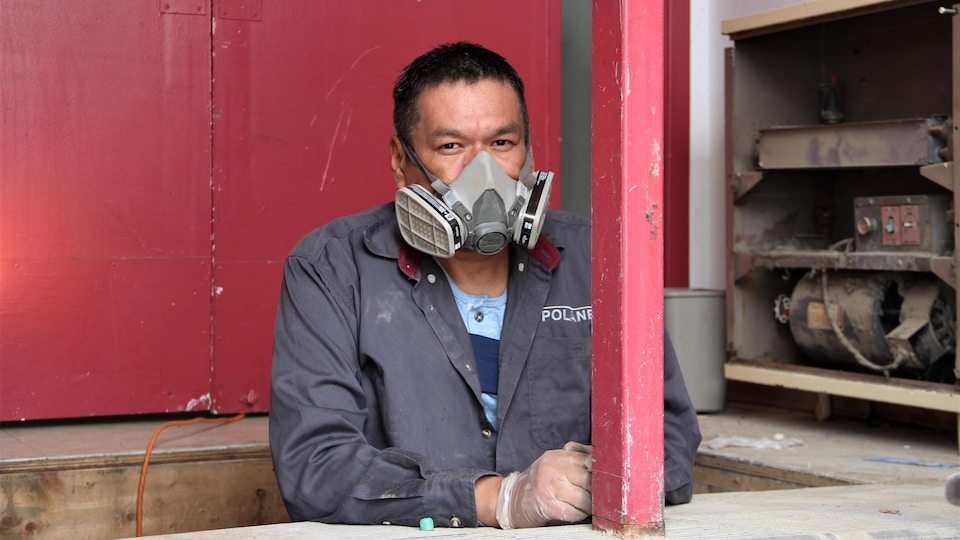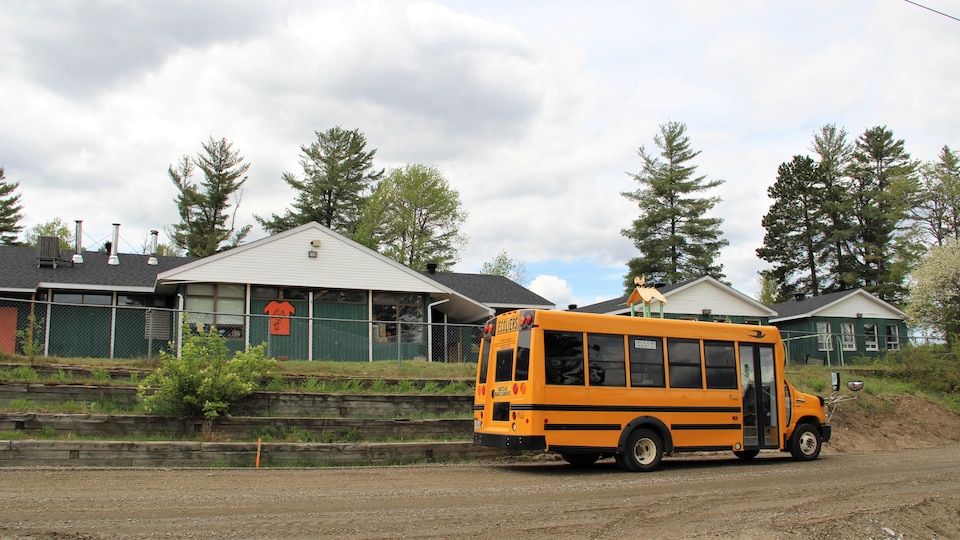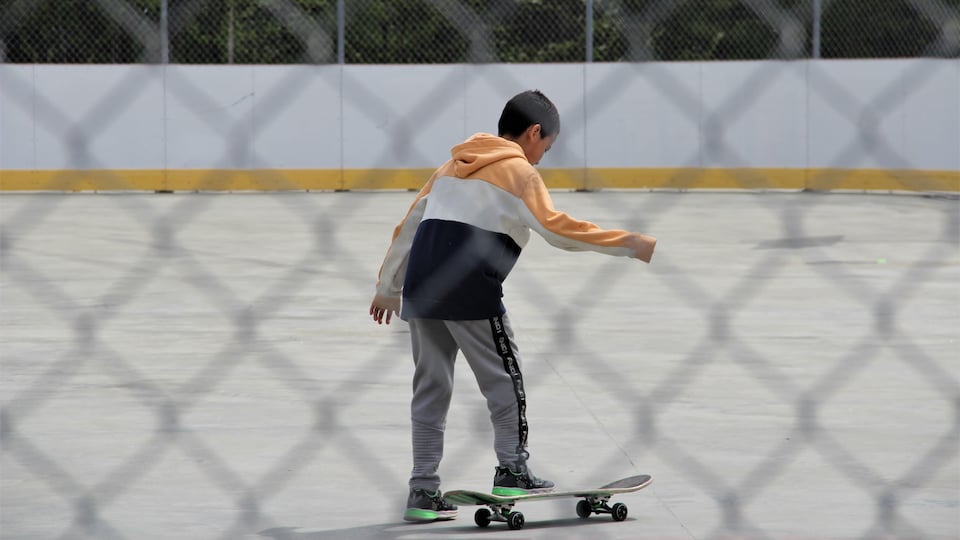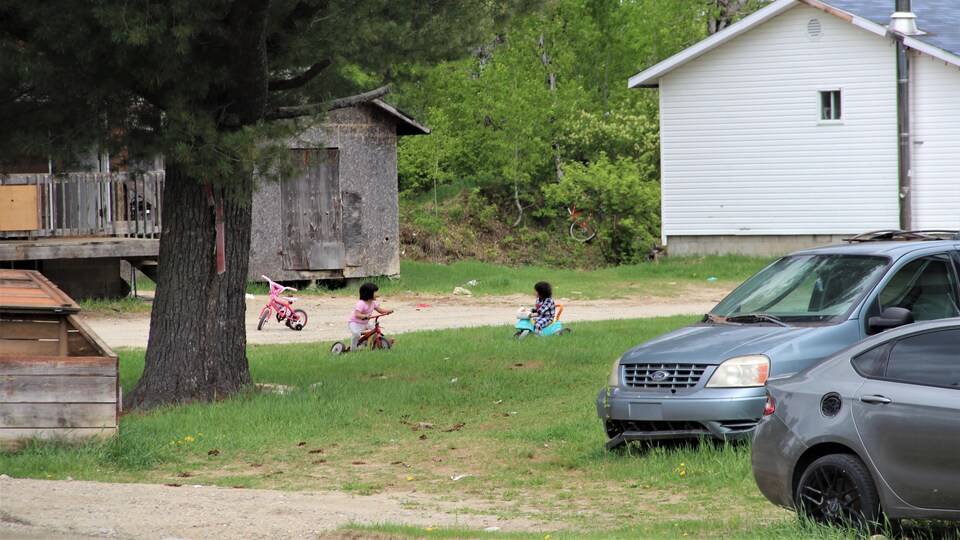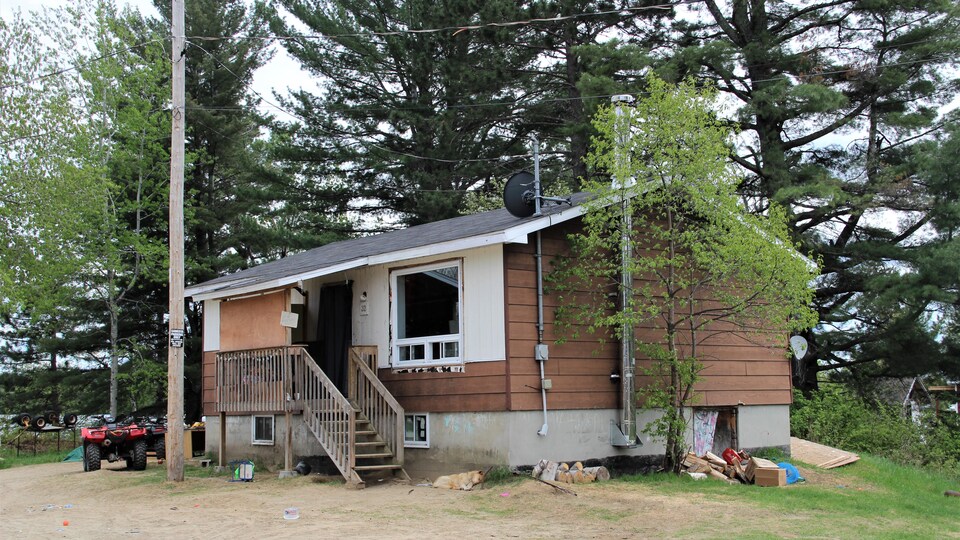For Lac-Barrière’s parents, the choice is difficult: send their children to continue their education and give them the keys to the future, or keep them at home, for their health, because school is attacked by mold. Not to mention the director who manages the school more than 660 kilometers away.
In front of one of the gates of the Kitiganik school on Lac-Barrière (about 150 km south of Val-d’Or), men are busy with wheelbarrows and shovels, protective masks over their faces. They were trying to remove the mold that had multiplied under the entire building.
They are not experts. Only employees of the band council of this Anishinaabe community. Larry Deschenes is the Director of Public Works in the community. He goes down the hole, to remove the mold. They shouldn’t be the ones to go there, he said, pointing the finger at the young workers. I’ll be the one to go.
Supporting images, it shows the extent of the damage. It is difficult to identify mold in the sand. But the smell that comes out is unmistakable. It seems like a few days ago it was even worse.
In the community, the problem of unclean education is known. Even Nicolas Moquin, spokesman for Indigenous Services Canada (ISC) acknowledges that the school is outdated.
Regarding the presence of mold, the ministry indicates that it was notified by the school principal on May 25. On the same day, Espaces INDIgenes went to Lac-Barrière to investigate and sent an email to the director requesting interview.
The mold problem is recurring and occurs after the snow melts, every year.
Some dared to speak about it openly for fear of retaliation from the band council. In this small and very fragmented community, getting out of problems can be costly according to some, such as unemployment.
Indigenous Spaces has garnered a dozen testimonials and they are all pointing in the same direction. Most are anonymous for fear of retaliation.
They say those who venture inside the school walls have red eyes, recurrent migraines and coughs after a few days.
Parents are complaining on social media and asking for answers and clearer communication from school principal and head Tony Wawatie.
Keyejee Papatie, the son of the former school director, worked some time at the establishment. 20 years ago we already had mold and we were always worried about our children’s health, but the council wasn’t listeninghe said in front of his house.
Casey Ratt, the former leader, has children who are studying themselves. He could smell the smell of mold. He calls on the leader to talk to the Canadian government, which is responsible for the community.
The leader must bring our grievancessaid Casey Ratt, and added that she, like many, is extremely concerned about the health of her children.
The deserted school
Many parents have decided not to send their children to school in recent weeks, so that they do not breathe in this unhealthy air. One of the people interviewed by Espaces Indiens explained that only 15 children resist the 80, 85 normal.
In the corridors, children don’t laugh, not toddlers run. The classrooms were almost empty. A teacher takes care of two young people.
Several closures were ordered by the band council and some teachers decided to continue their courses in another building, such as the one reserved for daycare.
These repeated closures are of particular concern to a school and daycare employee.
She wonders at the level of education of the children if they are not diligent in attending school. He is also concerned about possible visits by the Department of Youth Protection.
If the DYP came here and saw that the children were not studying, it was not the fault of the parents, but of our leaders. If we lose children, I will oppose it, and the whole community for that matterhe said, rubbing his chest.
The project was aborted
Everyone is waiting for the construction of a new school. This one, which is repaired annually, is over 50 years old according to chef Tony Wawatie and others.
In the current building, a plan of what could be the new community establishment is rolled up and lying in a corner.
This school, whose construction is supposed to have started in 2019-2020, has never shone. There were problems with the ground, where it was supposed to be built according to the new ruler.
Then, the regional director general attached to Indigenous Services at the time would first ask that the community be connected to the Hydro-Québec electrical network before providing the green light for the construction of a new school.
It is true that Lac-Barrière has only one generator.
The Canadian government knows this and the community is waiting to make a decision about its power supply before proceeding with the construction of the new school. The ball is then clearly on the band council court.
Until a final decision is made by the community on power supply, the construction phase of the project cannot proceed.speaker details for BAG.
Meanwhile, the ministry is funding the renovation. Last fall, BAG notably invested $ 275,000 to fix the roof.
SAC ensures that it works in partnership with the community. Besides, an advisory committee, which includes the Lac-Barrière education department and First Nations Quebec-Labrador Education Council (FNEC), was created to ensure the smooth running of the projectcontinued Nicolas Moquin of BAG.
Interviewees said they knew in advance what Chief Wawatie would tell reporters about it. And they are not mistaken.
In their view, the leader implies that the culprit is the government.
We had a big plan in 1997, but the government pulled out because our ideas were not in line with their colonialist policy.he assures, before deviating from the division that reigns within the community, on the problems of housing in general and drug consumption.
People are starting to lose patience. They keep telling us ‘we have a plan, we have a plan, we have a plan’, but where is that plan? We saw nothing. They have been trying to stall for yearslaunched one of the sources of Indigenous Spaces.
Some people surveyed also raised the fact that at the very moment, the work is being done community repairs and a baseball diamond were built. They would have preferred this money to go to building a new school.
Temporary solutions
Meanwhile, the chief said he was trying to find short -term solutions. As usual, the band council is trying to find places so the kids can get there until the mold problem is solved.
In the territory? In Maniwaki?
Here are the options on the table says the chef. Maniwaki is more than an hour’s drive from the community, which will force children to endure the long drive to school.
We ask for mobile homes, but they don’t want tosaid the chief again. they they are the government people.
The Invisible Man
In addition to the recurring mold, the new director, James McGrogan, a non -Aboriginal, was never on site. He was working instead from Toronto, according to various testimonies collected.
” He’s not from here, he’s a white guy who never comes to meet the team, the kids, he never set foot in our school and he’s out there, making decisions for everyone. “
Another detail he didn’t even introduce to the team.
At Lac-Barrière, James McGrogan was nicknamed by some the invisible Person. Despite our two reminders, he did not respond to our interview requests about the state of the school he himself runs.
One of our resources added: I told the boss we had to get someone to come to school, someone to take it to heart, who was going to see the mold. I don’t see how he can make decisions without herhe says.
” The director should be here, on the front line. “
Chief Tony Wawatie is well aware of this situation. We welcomed him in the midst of a pandemic (fall of 2021, editor’s note). All this time, things were hard to move. I take responsibility for his absence from the community. We ask him to gohe said modestly.
Many also criticize the band council and the school administration for the lack of transparency. They accused the boss of not being present enough in the community, of not getting an answer from him when they ask him questions.
For example, an inspection report was made after the experts visited the school. The chief himself spoke about this report in an interview. Employees would have liked to consult this. Despite Aboriginal Spaces ’requests, it was not sent to us by the band council.
In the meantime, Chief Wawatie assured put pressure in government.
Some members are seriously considering giving an ultimatum to the Chief and Council: they can do something and fast, or the matter will be taken to court.
Source: Radio-Canada
